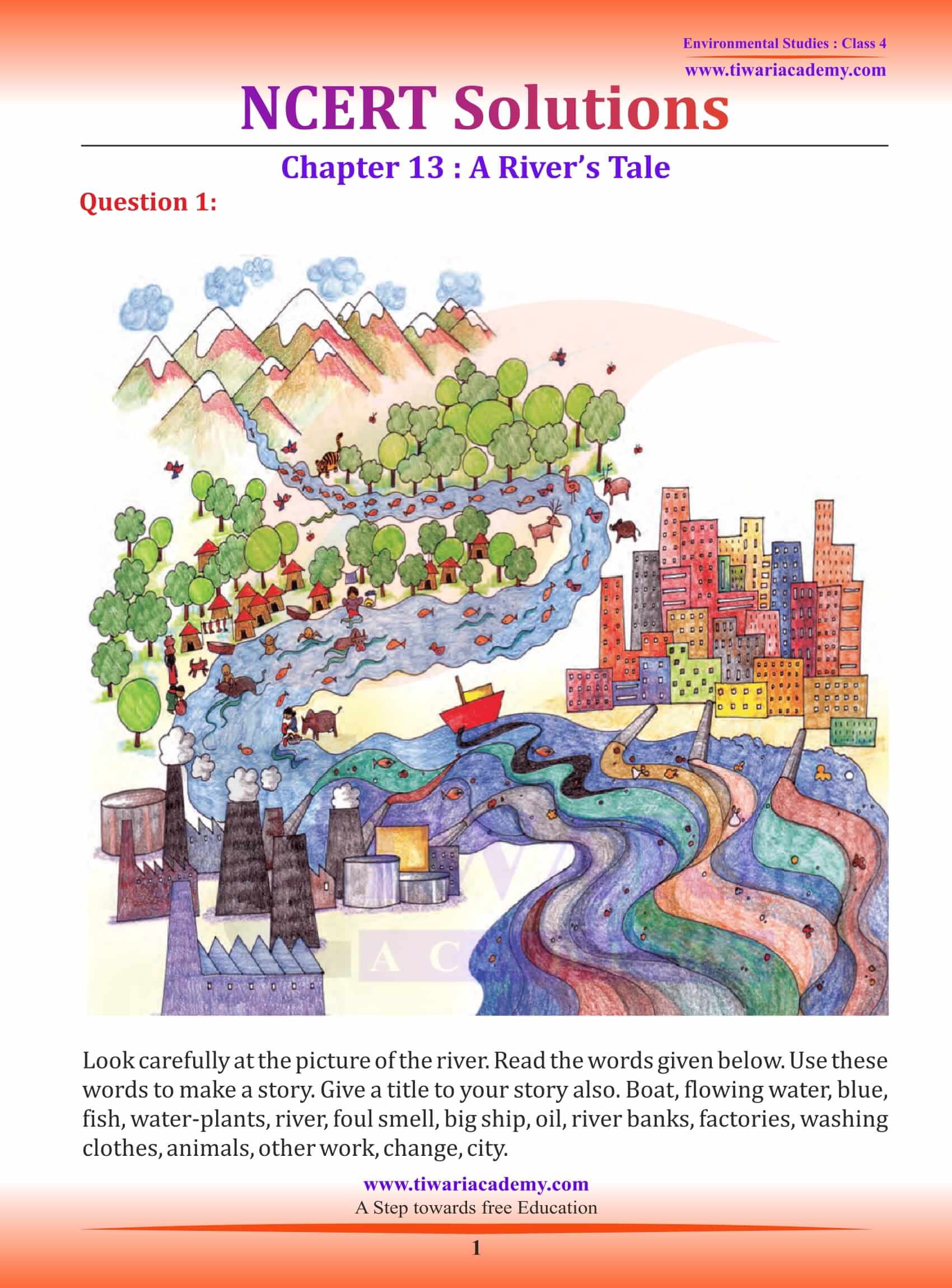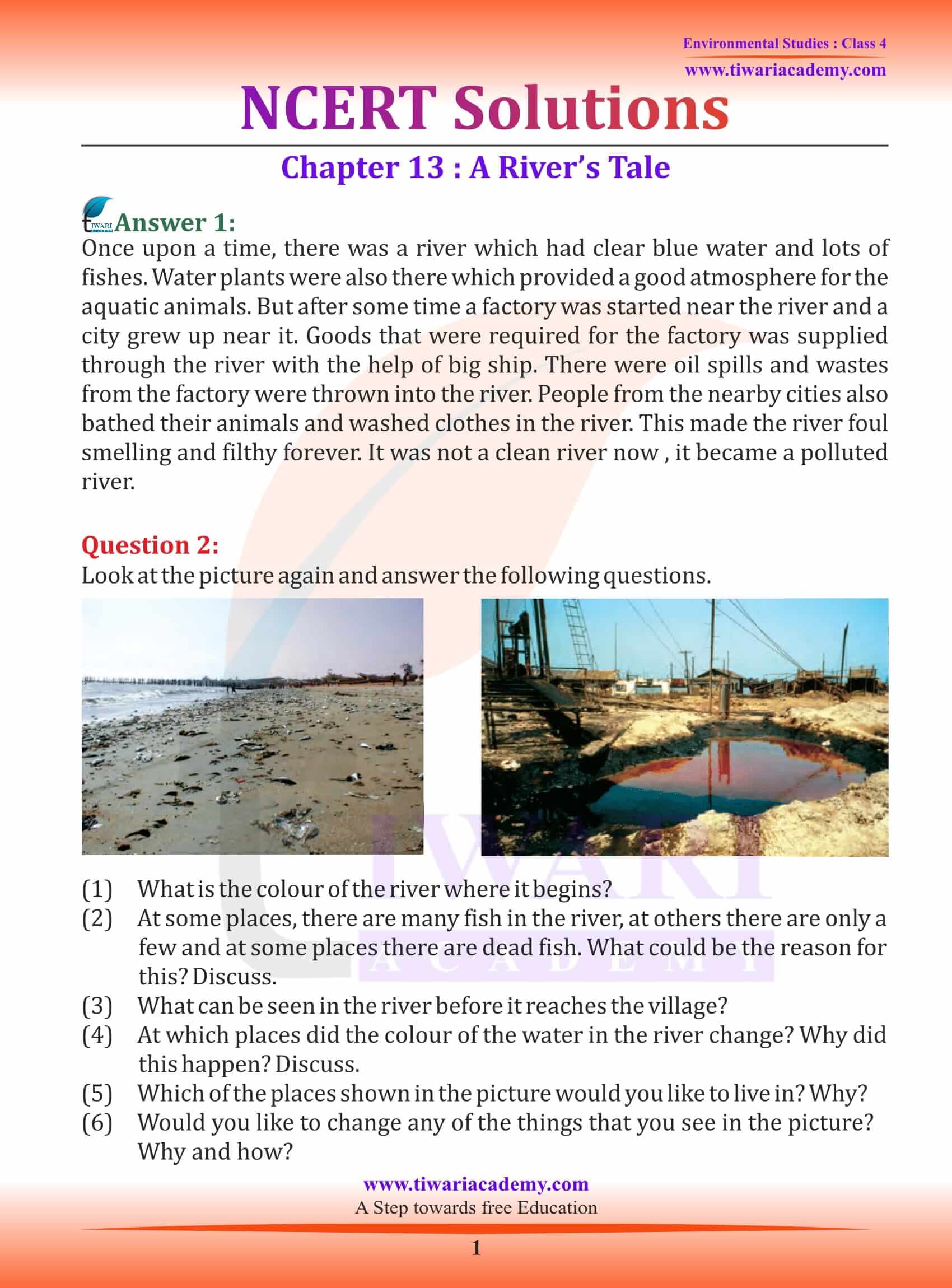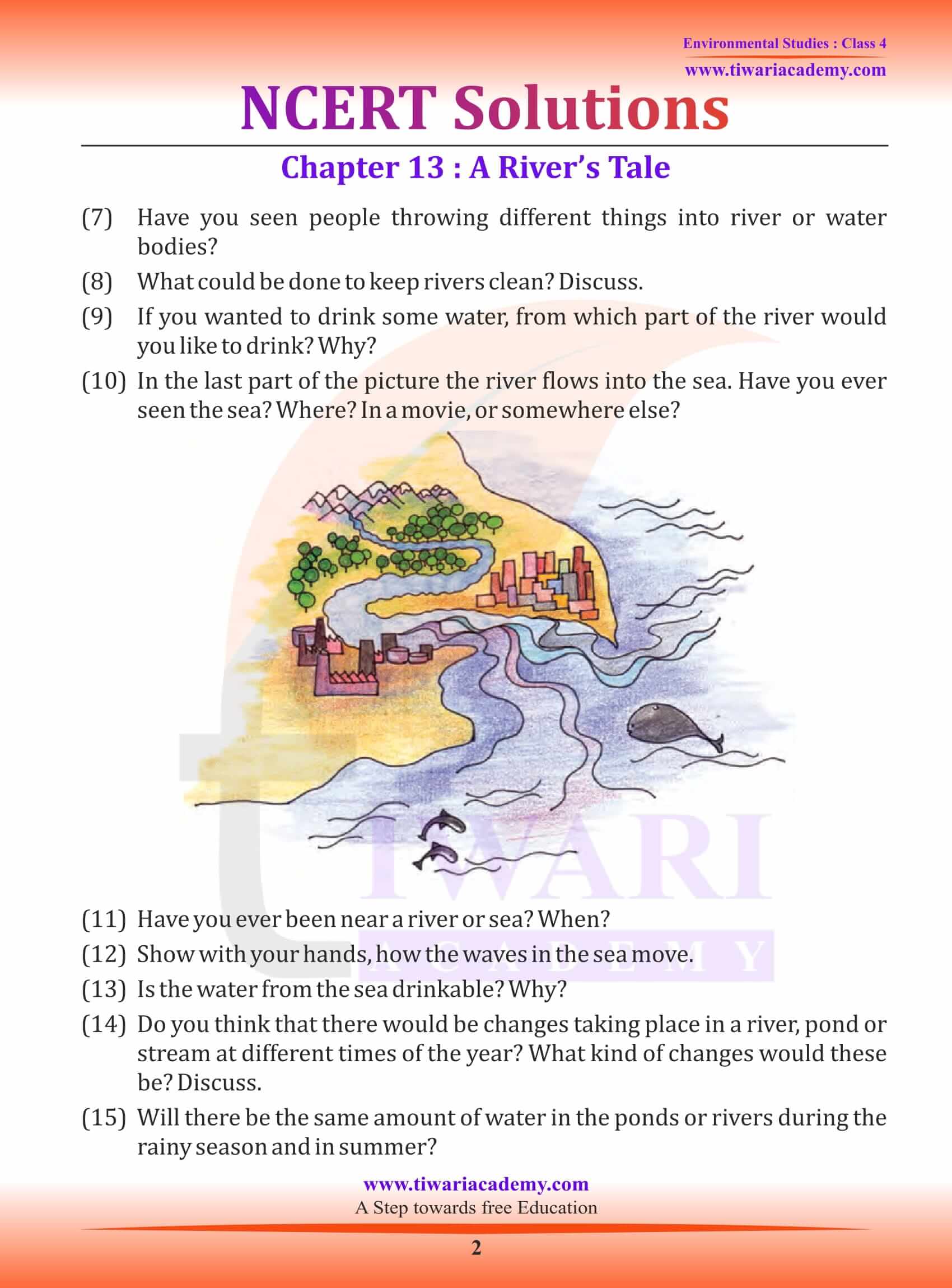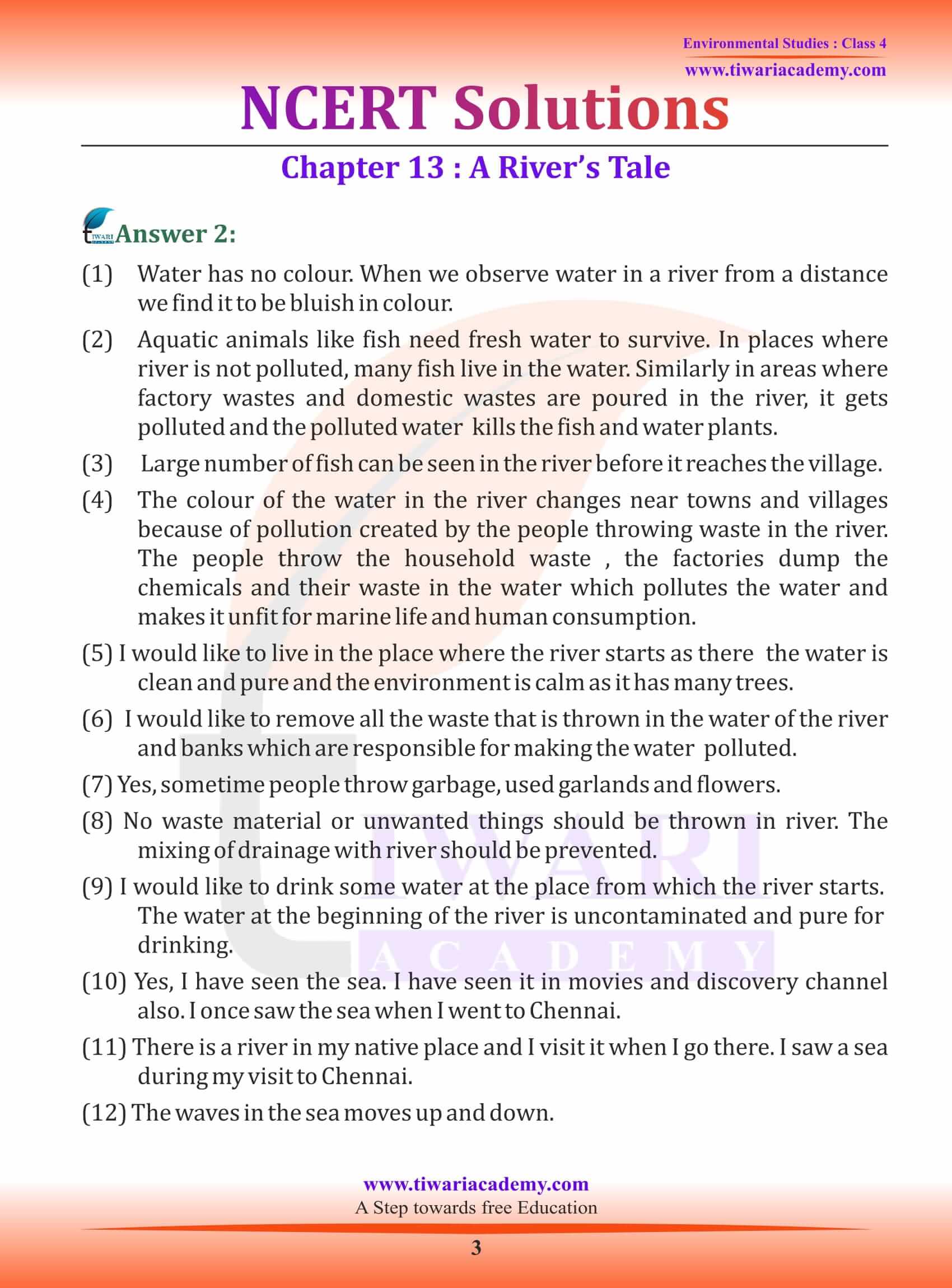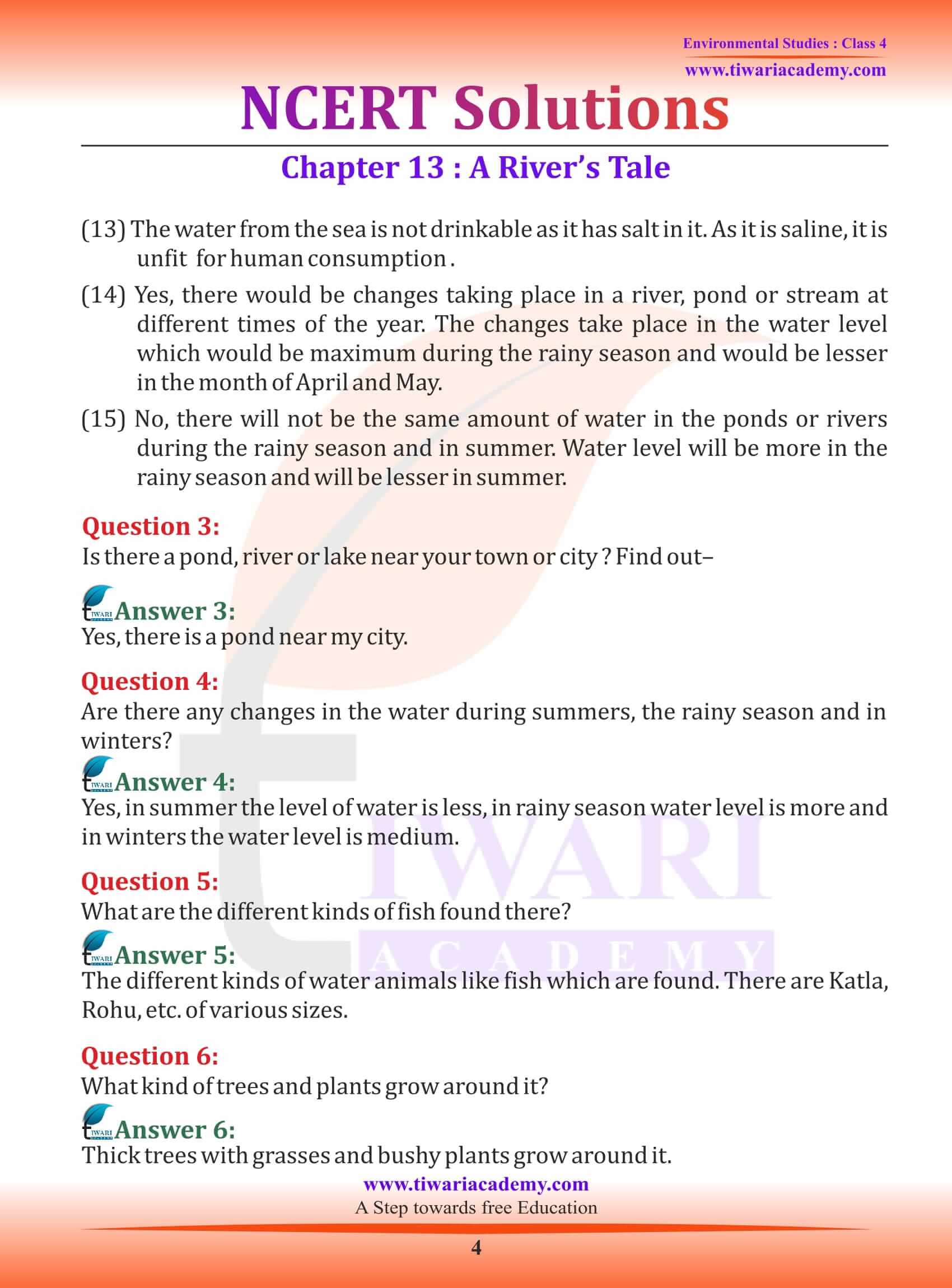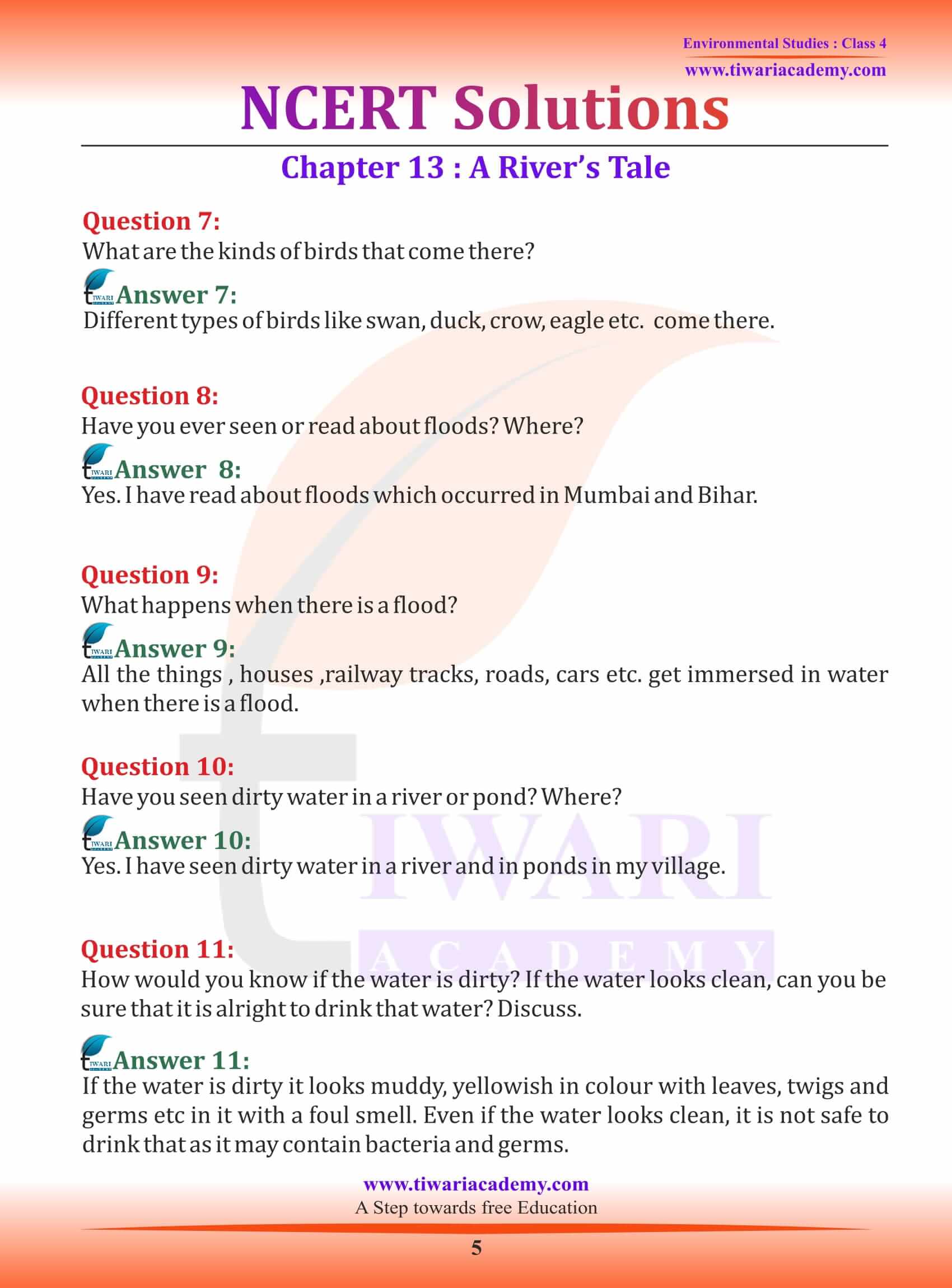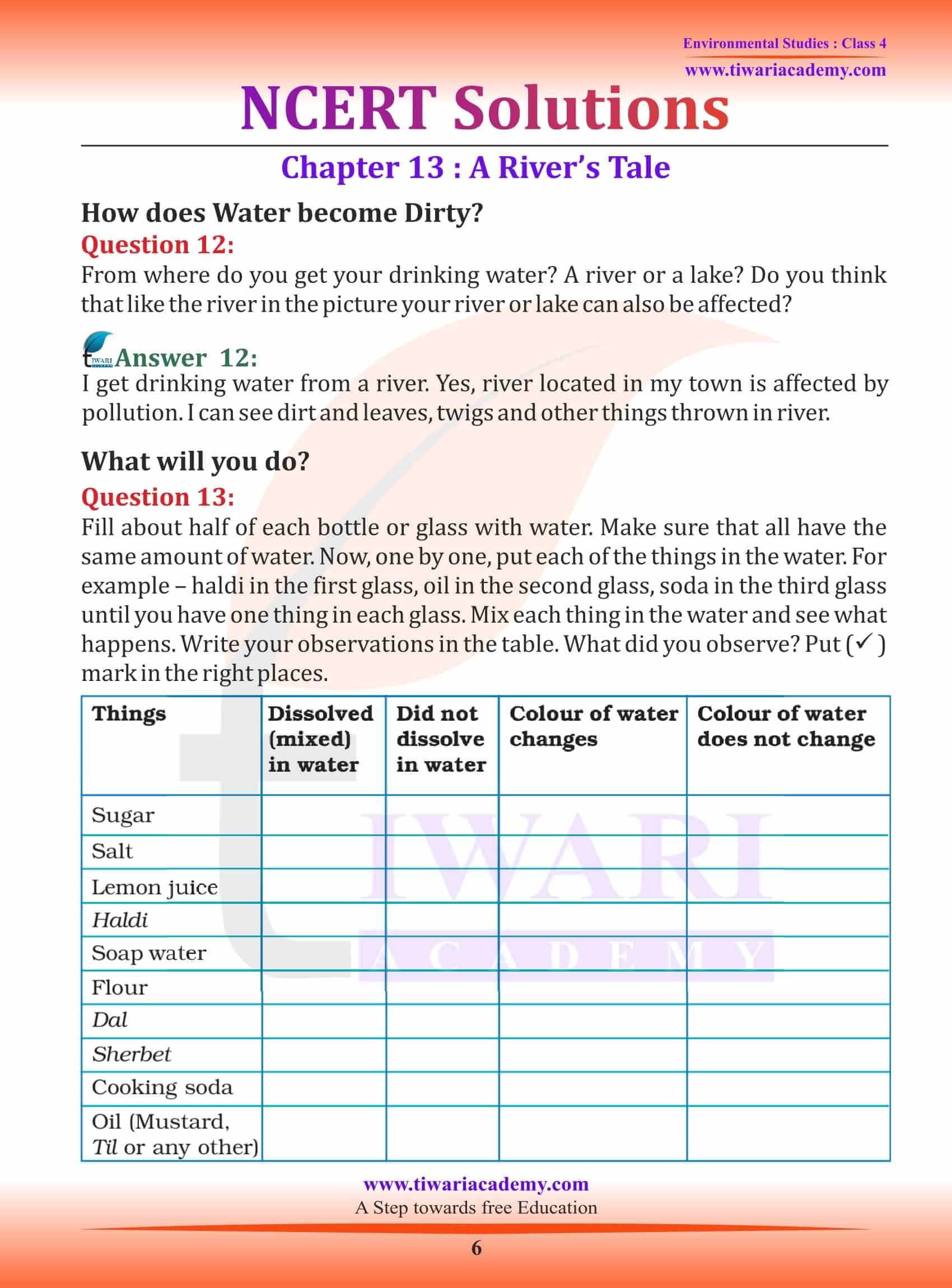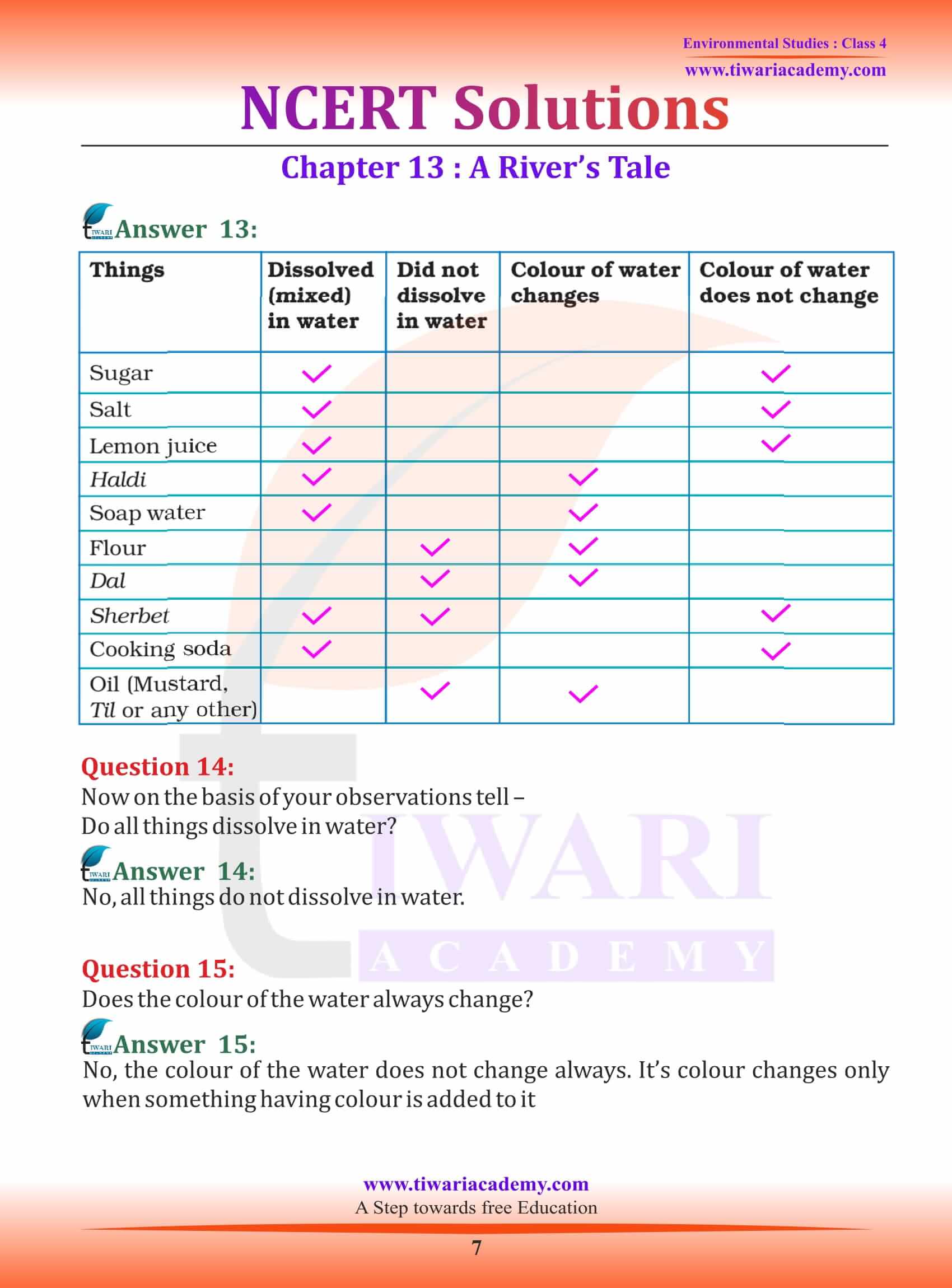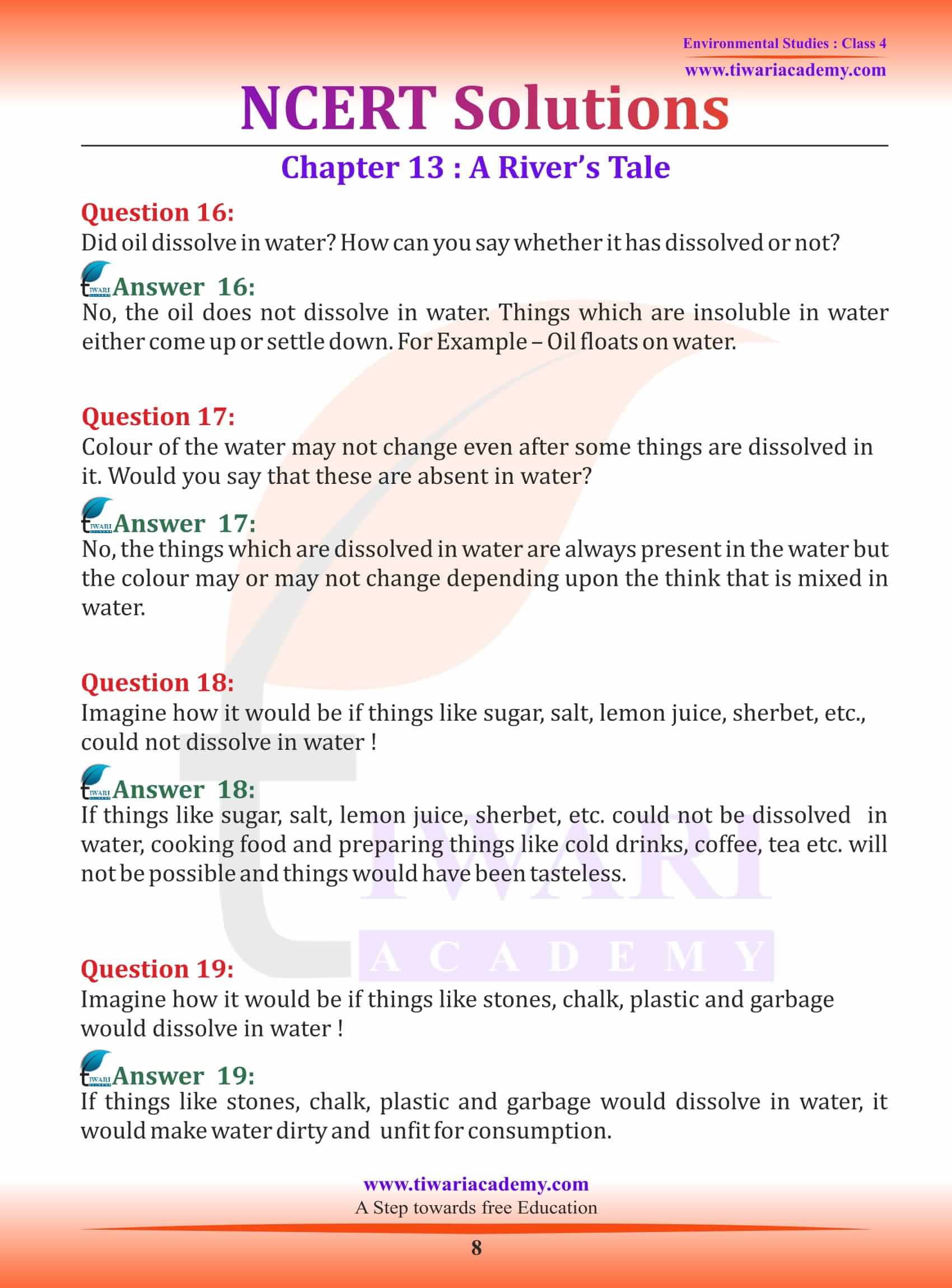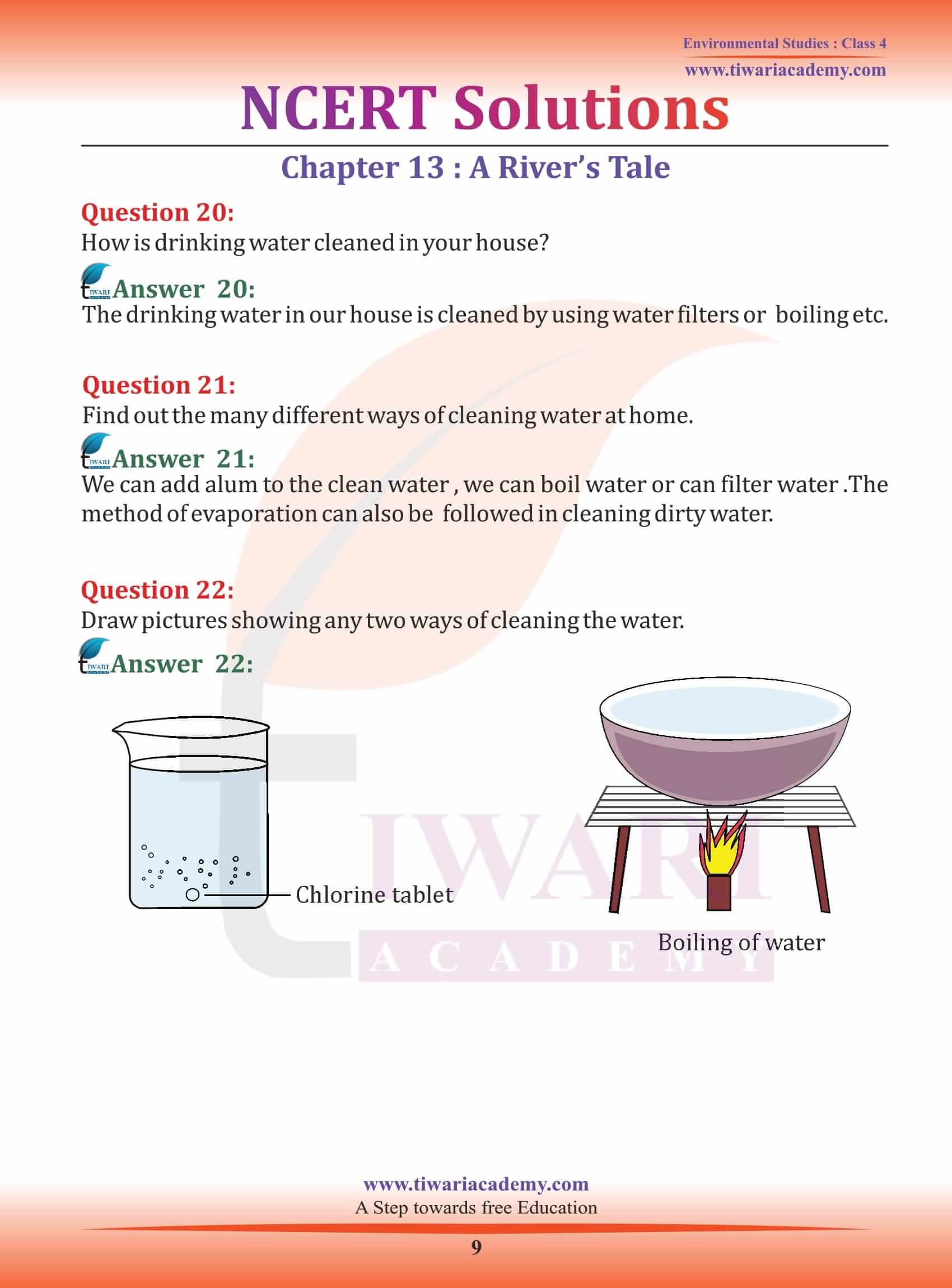NCERT Solutions for Class 4 EVS Chapter 13 A River’s Tale in Hindi and English Medium updated for new academic session 2025-26 free to use online or download in PDF file format. After completing the NCERT exercises questions students must practice the extra questions given here with answers and explanation. NCERT questions and extra question are important for examination point of view. Almost all the questions are easy to understand or learn.
NCERT Solutions for Class 4 EVS Chapter 13
Class 4 EVS Chapter 13 Question Answers with Important Extra Questions
Class 4 EVS Chapter 13 Question Answers Set 1
What is the colour of the river where it begins?
The colour of the river water appears blue at the place where it begins.
At some places, there are many fish in the river, at others there are only a few and at some places there are dead fish. What could be the reason for this? Discuss.
The fishes need fresh and clean water. People throw their useless and waste materials into water due to this water become polluted. those places where water is polluted that place becomes unfit for fishes.
What can be seen in the river before it reaches the village?
Before the river reaches the village, its water is clean and fresh. There are many fish in it and many other animals and birds come to it.
At which places did the colour of the water in the river change? Why did this happen? Discuss.
The colour of the water in the river changes when it reaches the city. This is because the industrial waste, the sewage and the garbage from the city are thrown into it, these things polluting it.
Are you knowing any such river which change due to pollution?
Yes, this is the river Yamuna in front of us. Water of river Yamuna is looks dark and it’s smell is very bad. This due to pollution.
Which of the places shown in the picture would you like to live in? Why?
I would like to live near the place from where the river begins because I can get fresh air and fresh water at that place.
Class 4 EVS Chapter 13 Question Answers Set 2
Would you like to change any of the things that you see in the picture? Why and how?
I would like to remove the waste from the banks and in between water of the rivers. Because of these wastes river water is getting polluted.
Have you seen people throwing different things into rivers or water bodies?
Yes, I have seen people throwing flowers, ashes of dead humans, religious statues, etc. in river water. I have also seen some people living near the rivers throwing garbage in the river water.
What could be done to keep rivers clean? Discuss.
First of all, we should spread awareness among People about the consequences of polluting water bodies and rivers. today we are facing a big problem of drinking water and this may become more difficult in future if we will not stop. for this all the people take care of this that no one should wash their clothes and bathe their animals in the river water. The sewage and the industrial waste should not be dumped directly into the river. Both sewage and the industrial waste should be first treated to remove the harmful chemicals and solid waste before dumping into rivers.
If you wanted to drink some water, from which part of the river would you like to drink? Why?
I would like to drink water at the upper reaches from the beginning of the river. The water near the source of a river is pure and uncontaminated.
In the last part of the picture the river flows into the sea. Have you ever seen the sea? Where? In a movie, or somewhere else?
Yes, I have seen the sea. I saw the sea in films also. Apart from that, I saw the sea when I was in Mumbai.
Have you ever been near a river or sea? When?
There is a river in my city and I often cross the river. I have been near a sea during my trip to Mumbai.
Class 4 EVS Chapter 13 Question Answers Set 3
Is the water from the sea drinkable? Why?
The water from the sea is not drinkable because it is very salty, which is not good for health.
Do you think that there would be changes taking place in a river, pond or stream at different times of the year? What kind of changes would these be? Discuss.
In the summer season, the water level of the water bodies, such as river, pond or stream, decreases due to the evaporation of water but water of Himalayan rivers increases due to excess ice melt. In the rainy season, the water level of the water bodies rises. The water of the ponds in higher places freezes in the winter in places where the climatic conditions are very cold.
Will there be the same amount of water in the ponds or rivers during the rainy season and in summer?
During the rainy season, the level of water in a river, pond or stream is at its maximum, while in the April and May the water level is at the minimum.
Is there a pond, river or lake near your town or city? Find out:
Yes, this is delhi city which is situated across the river Yamuna.
Are there any changes in the water during summers, the rainy season and in winters?
As I have seen, there is no change in summer and winter season because all the water in river Yamuna used for drinking purpose. The water flowing across Delhi is home and industrial waste. But in rainy season there is flood like situation and muddy water.
Question:
Show with your hands, how the waves in the sea move.
Answer:
The sea waves move up and down either in forward or in backward direction.
Class 4 EVS Chapter 13 Question Answers Set 4
What are the different kinds of water animals found there?
I have not seen any water animal in the river Yamuna across Delhi because water is polluted at drastic level.
What kind of trees and plants grow around it?
There are different types of tree and plant on bank of river Yamuna. Some people growing vegetables and seasonal fruits around it.
What are the kinds of birds that come there?
There are several type of birds come where water clean. Some of them are Eagle, crow, swan, etc.
Have you ever seen or read about floods? Where?
Yes, flood is common problem in India at time of rainy season. I have also seen flood in river Yamuna.
What happens when there is a flood?
There is excess of water everywhere. Water enters even in houses. People suffer a lot.
Class 4 EVS Chapter 13 Question Answers Set 5
Have you seen dirty water in a river or pond? Where?
Yes, I have seen dirty water in a rivers and in some ponds also.
How would you know if the water is dirty? If the water looks clean, can you be sure that it is alright to drink that water? Discuss.
Pure water is clean and clear. Dirty water is not so. Even if the water looks clean, it may not be alright to drink that water. It may contain germs that causes diseases.
Did oil dissolve in water? How can you say whether it has dissolved or not?
No, oil may not dissolve in water. We can see oil floating over water.
How is drinking water cleaned in your house?
Water can be cleaned by following different ways:
(a) By boiling the water
(b) By adding alum to water
(c) By adding chlorine to water
(d) By filtering water using water purifiers
Find out the many different ways of cleaning water at home.
at home we can purify water by different methods like, alum can be added to clean the water. Water is purified by the method of evaporation.
Class 4 EVS Chapter 13 Extra Question Answers Set 1
Why are rivers important?
Rivers are important as-
• They carry sediments and minerals which are very useful for us
• They make the soil fertile by depositing the sediments and silt etc on the river banks.
• They provide a cheap and efficient inland transport for trade and commerce.
• They help cities and towns in carrying their wastes.
• Their water is widely used in irrigation and in developing hydroelectricity.
• They provide habitat and food for organisms
• Plays an important role in water cycle
What is pollution?
Pollution is the addition of harmful materials into the environment. These harmful materials are called pollutants. It refers to any substance that harmfully impacts the environment or organisms that are living within the affected environment. The major types of pollution include: air pollution, water pollution, soil pollution and noise pollution.
What does water pollution mean?
Water pollution is the pollution of the water bodies, such as lakes, rivers, seas, the oceans, as well as groundwater. It takes place when the pollutants reach these bodies of water, without any treatment. Waste from homes, factories and other buildings get into the water bodies and the water gets contaminated
How do the rivers get polluted?
The rivers get polluted by-
• Throwing of some harmful substances in them
• Dumping sewage and other solid waste
• Opening the city drains into rivers
• Draining waste water of factories into rivers
• Plastic and metal can, bottles etc being thrown in water
• Poisonous substances like pesticides and fertilizers
Question:
What is a river?
Answer:
A river is a large water body or a natural stream of water which originates from the mountains and falls into an ocean or as sea or any other water body.
Class 4 EVS Chapter 13 Extra Question Answers Set 2
What measures should be taken to keep the river water clean?
The following measures should be taken to keep the river water clean-
Do not litter or dump any kind of waste material in water
Use less water at home to reduce burden 0n sewage treatment plants
Use organic gardening to reduce the use of chemical fertilizers
Create awareness about not washing clothes or bathing animals in the rivers.
Maintaining sanitation around the water sources.
What is Sewage?
Sewage is that liquid waste which has water as its largest component along with various types of impurities like waste water from houses, offices, factories, hospitals etc.
What does sewage treatment plant mean?
Sewage treatment or the domestic wastewater treatment is a type of wastewater treatment which aims to remove the contaminants from sewage to produce an waste matter that is suitable for release to the surrounding environment thus preventing water pollution
Sea water is unfit for drinking give reason.
Sea water is very salty. High amount of salt rapidly cause dehydration, loss of water in our body and in some cases cause death too. That is why sea water is unfit for drinking.
We should not drink water from rivers and lakes directly?
We should never drink water from a natural source directly whether it is a river or a lake as that is not purified, even if the water looks clean. Water in a stream, river or lake may look clean, but it can still be filled with dirt, germs like bacteria, viruses, and parasites that can result in waterborne diseases.
Class 4 EVS Chapter 13 Extra Question Answers Set 3
Why do we sometimes see dead fish floating on the rivers?
Water pollution is harmful for the aquatic animals too. Spreading of harmful substances such as oil, plastics, waste from factories and chemicals into water harms the aquatic animals. They can take in all these things through their skin or food and water intake and can die.
Why does the colour of water changes when they flow through the cities?
The colour of the water in the river changes when it enters the city, town or village. This happens because the industrial waste, garbage and sewage are thrown into it which make it highly polluted.
The levels of water are not the same in rivers and lakes during different seasons. Why?
The level of the water in rivers and lakes is always changing due to inflows and outflows of water. The reason for this can be precipitation, overland runoff, groundwater seepage etc. So, the amount and location of surface water changes over time and space, whether naturally or with human help.
What is a Solute?
Any substance that dissolves or is added into a liquid is called a solute. Eg: salt, sugar
What is a Solvent?
A liquid (water) in which the solute is added or dissolved is called a solvent. Eg: milk, water.
Class 4 EVS Chapter 13 Extra Question Answers Set 4
What is a Solution
When a solute completely dissolves in a solvent and disappears, a solution is forms. Eg: salt and water when added make saline water solution.
Which substances did not mix with milk while preparing the fruit custard? What are these substances called?
The substances which do not mix with milk are fruit pieces, dry fruits. Such substances which do not mix in a liquid are called Insoluble substances. Eg: chalk powder, sand, pebbles, grass etc.
What does purification of water mean?
Water Purification is the process of removing undesirable and unwanted substances from water which contaminate the water. This method is followed especially for the purification or cleaning of drinking water to make it free of impurities and fit for consumption.
What are the different methods of water purification?
The different methods of water purification are-
Boiling- It is one of the most effective method of purifying or cleaning water at home of all the impurities and germs and make water safe for drinking.
Chlorination /Bleaching- By putting correct amount odf ch;orine or bleaching powder can also disinfect or purify water and make it fit for drinking. The chemicals kill the germs but they should be used in small quantity to avoid poisoning.
Filtration- There are different ways to filter water at home-
i. Cloth filter- Use cotton or muslin cloth in case of extreme emergency although this method may not be very effective as it can remove only big sized impurities and not the smaller ones or germs.
ii. Commercial filters- They are highly successful in removing all the impurities from the contaminated water.
Give a few examples of commercial filters.
A few examples of commercial filters that are being used by us today are-
Ceramic Candle Filters- eg. Pure it
Reverse Osmosis (RO) – eg- Kent, Aquasure
UV (Ultra Violet Filters) –eg-Aqua guard, Aqua fresh
Class 4 EVS Chapter 13 Extra Question Answers Set 5
What are the causes of a flood?
The floods can be caused due to:
Overflowing of water in rivers and streams
Damage to dams, breaking of the walls of dams
Coastal areas getting flooded due to Tsunami
Heavy rainfall
Deforestation
Melting of snow and greenhouse effect
Climatic changes
Destroy bridges, highways, buildings etc
Damage power house and
Cause deadly water borne diseases
What are the effects of a flood?
The floods cause widespread damage to crops, domestic animals, property and human life. During floods, many animals get carried away by the force of water and eventually die.
How can we control the floods?
The floods can be controlled by-
Planting more trees as trees help in controlling floods
terrace slopes to reduce slope flow
building man-made channels to divert water from flooding
construction of dykes, dams, reservoirs or holding tanks to store extra water during flood periods.
Question:
What is a flood?
Answer:
Flood is a natural disaster which occurs when a large amount of water from the water bodies overflows beyond its normal limits and submerges the land which is otherwise dry.
Do you think chapter 13 of class 4 is about development too?
After reading the chapter I found the chapter is about the negative side of development as the chapter tells you how the river is being polluted because of the mixture of various harmful things that are not only harmful to us but for the marine life too.
What are the main topics in chapter 13 of class 4th EVS that can be covered to cover the chapter in a short time?
The chapter is shedding light on the reasons why and how the river is being polluted, reasons for pollution, and the easiest explanation of mixtures in the harmful component in the water and how that can harm us.
How important do you think chapter 13 of class 4th EVS is?
I think the chapter showed us the negative aspect of rapid development in the country’s capital and how the toll of such development is borne by our river. Being the source of drinking fresh water for the mass it is affecting the millions of population at a time. So, saving such a source of water is vital for sharing the information at such an early age is important so that they can be careful from an early age.
What is the objective of chapter 13 of class 4 EVS?
I think the objective of this chapter is to provide knowledge to children about the pollution that is affecting the environment and along with the steps that can be taken to avoid the harmful effects because of the pollution. Especially water pollution as during play children needs water and in the absence of it, they try to consume from the nearest source of water without caring about the cleanliness of the source and water that could be the reason of many diseases.
